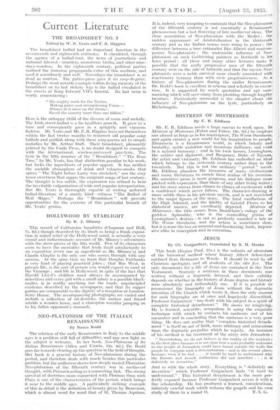NEO-PLATONISM OF THE ITALIAN RENAISSANCE By Nesca Rodd The relation
of the early Renaissance in Italy to the middle ages is a problem still full of difficulties, and any new light on the subject is welcome. In her book, Neo-Platonism of the Italian Renaissance (Allen and Unwin, 12s. ad.), Dr. Rodd goes far towards clearing up the question in the field of thought. Her book is a general history of Neo-platonism during the period, and therefore deals with much besides this particular problem, but the authoress shows how deeply rooted Florentine Neo-platonism of the fifteenth century was in mediaeval thought, with Petrarch acting as a connecting link. The strong survival of doctrines more connected with Plotinus than with Plato is one of the characteristics of the period, which brings it near to the middle ages, A particularly striking example of this in detail is the definition of beauty given by Benevieni, which is almost word for word that of St. Thomas Aquinas.'
It is, indeed, very tempting to maintain that the Neo-platonism: of the fifteenth century is not essentially a • Renaissance. phenomenon but a last flowering of late mediaeval ideas. The close association of Neo-platonisin with the Medici ; the sudden appearance of Aristotelianism in the thirteenth century just as the Italian towns were rising to power ; the difference between a true, rationalist like Alberti and contem- porary Neo-platonists ; the undeniable influence of Neo- platonism on such Gothicizing painters as Botticclli in his later period : all these and many other features make it, possible that the really progressive men of the fifteenth century were .on the side of Aristotle and that the mystic Neo- platonists were a noble survival more closely associated with reactionary tyranny than with civic progressiveness. As. a history of Neo-platonism during the earlier Renaissance, Dr. Rodd's book is excellent in scheme and scholarly in exceu-, tion. It is supported by much quotation and apt sure-' rnarizing which will save many from plodding through lengthy treatises. Particularly successful is the chapter about the influence of Neo-platonism on the lyric, particularly on Michelangelo.


































 Previous page
Previous page